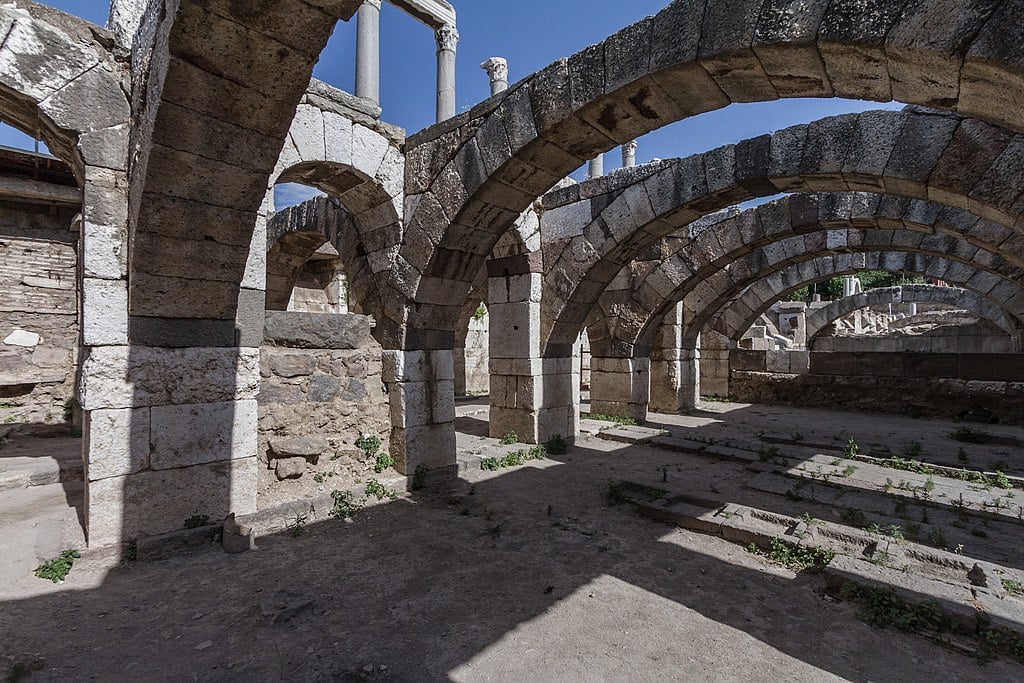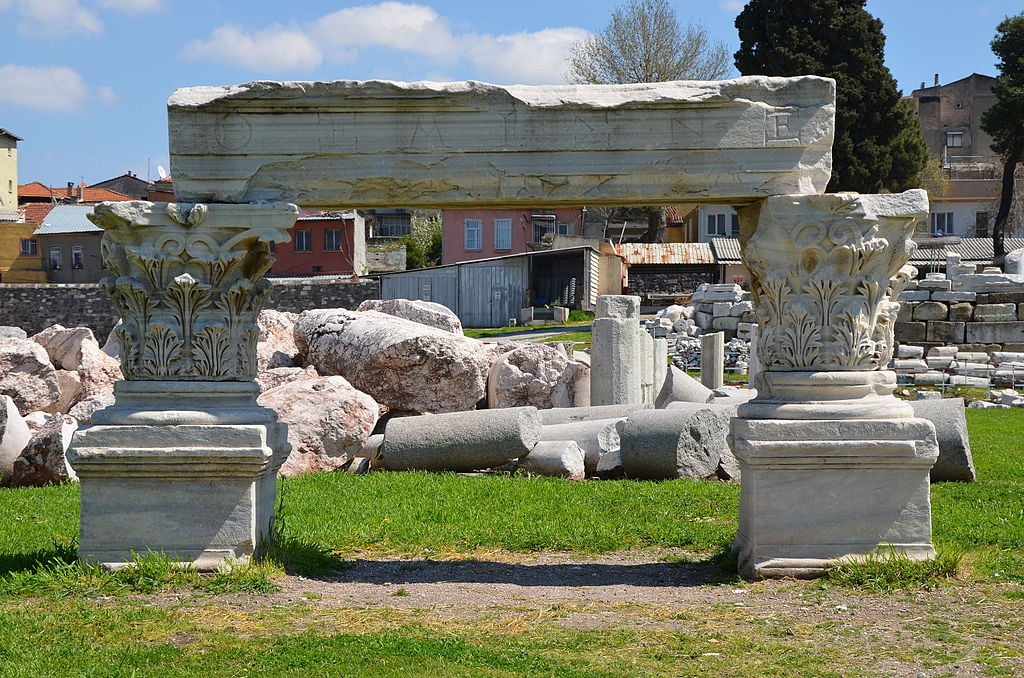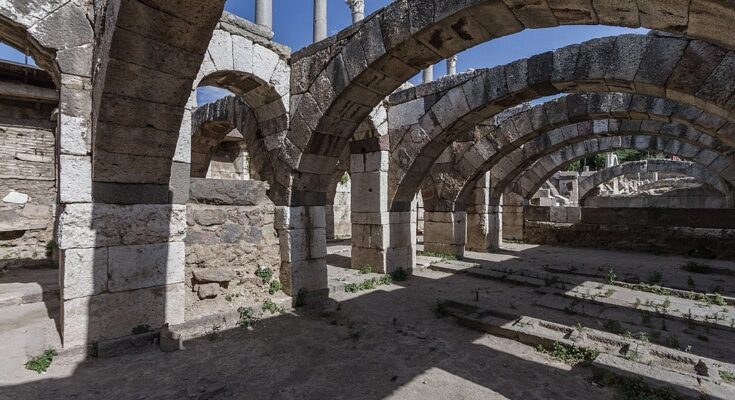
Smyrna was once one of the most illustrious of all ancient and Hellenistic-era Greek cities. One of the main centers of Greek settlement in western Anatolia, it once had a temple dedicated to Athena and was the residence of the epic poet Homer.
Rebuilt during the Hellenistic era, it flourished for some time, becoming a hub of Armenian and Greek culture for many years even after the Turkish occupation of the area centuries later. It remained a commercial and cultural hub of Asia Minor until the cataclysmic destruction of the city in 1922 at the hands of the Turks.
On that fateful day in April of 1922, the Greek presence at Smyrna was ended, and much of their historical legacy in Asia Minor was erased from the map.
Ancient city of Smyrna a hub of Greek, Armenian cultures
Located at a strategic point on the Aegean coast of Anatolia, the oldest remains of the city, likely founded by indigenous peoples, are within the city that is now called Izmir, Turkey.
Smyrna had first risen to prominence during the Archaic Period as one of the principal ancient Greek settlements in western Anatolia. The second flourishing of the city occurred when it reached the status of a metropolis during the Roman Empire.
Ancient Smyrna was founded in approximately the 11th century BC, first as an Aeolian settlement, and later taken over and developed during the Archaic Period by the Ionians. Smyrna proper was the new city to which residents moved in the 4th century BC, whose restoration to glory was inspired by Alexander the Great.
Legend says that the city derived its name from an eponymous Amazon named Σμύρνα (Smyrna), which was also the name of a quarter in the city of Ephesus.
In inscriptions and coins, the name often was written as Ζμύρνα (Zmýrna), with Ζμυρναῖος (Zmyrnaîos, meaning “of Smyrna”).
The name Smyrna may also have derived from the ancient Greek word for the expensive aromatic substance known as myrrh, smýrna, which was the chief export of the city in ancient times.
Third millennium to 687 BC
The region was settled at least as of the beginning of the third millennium BC, or perhaps even earlier, as suggested by finds made in excavations since 2005. Throughout classical antiquity, Smyrna was a leading city-state of Ionia with influence over the shores and islands of the Aegean.
The early Aeolian Greek settlers of Lesbos and Cyme, expanding eastwards, occupied the valley of Smyrna. It was part of the confederacy of Aeolian city-states, marking the Aeolian frontier with the Ionian colonies.
Smyrna was located at the mouth of the small river Hermus at the head of a deep arm of the sea that reached far inland. This enabled Greek merchant ships to sail into the heart of Lydia, allowing the city to become part of a major trade route between Anatolia and the Aegean.
During the 7th century BC, Smyrna rose to power and splendor, as evidenced by its construction of a magnificent temple dedicated to Athena at that time. A strong military fortress was built, most likely by the Smyrnaean Ionians to command the valley of Nymphi, the ruins of which are still imposing.
According to Theognis, who was writing during the 500s BC, it was nothing other than the sin of pride that destroyed Smyrna. The historian Mimnermus lamented what he called the degeneracy of the citizens of his day, who could no longer stem the advances from the Lydians.
Finally, the Lydian king Alyattes, who lived from 609 to 560 BC and who was the father of King Croesus, conquered the city and sacked it; although Smyrna did not cease to exist, Greek life and political unity were destroyed, and the polis was reorganized as a village.
Smyrna is mentioned in a fragment of Pindar and in an inscription in 388 BC, but its greatness was long past at that time. Alexander the Great conceived the idea of restoring the Greek city in a scheme that was, according to Strabo, actually carried out under Antigonus, who lived from 316 to 301 BC and Lysimachus, who lived from 301 BC to 281 BC, who enlarged and fortified the city.
The ruined acropolis of the ancient city, the “crown of Smyrna,” had been on a peak about 380 meters (1,250 feet) high, which overlooks the northeast part of the gulf. The modern city was constructed atop the later Hellenistic-era city.

The ruins of a temple are still on the summit of the mountain. The walls built under Lysimachus crossed the summit of this hill, and the acropolis occupied the very top. The road from Ephesus entered the city by the Ephesian gate near which was once a gymnasium.
Closer to the acropolis, the outline of the stadium is still visible, and the theater was situated on the north slope. Smyrna once possessed two harbors; the inner bay was a small basin with a narrow entrance which was partially filled up by Tamerlane in 1402 AD.
In 133 BC, when the last Attalid king, Attalus III, died without an heir, his will conferred his entire kingdom, including Smyrna, to the Romans. They soon made it part of the Roman province of Asia, with Pergamum as the capital. Smyrna remained a major seaport and one of the principal cities of Roman Asia, vying with Ephesus and Pergamum for the title “First City of Asia.”
A Christian church and a bishopric existed here from the very early days of Christianity, most likely originating in the considerable Jewish colony there. It was one of the “Seven Churches” addressed in the Book of Revelation.
Saint Ignatius of Antioch visited Smyrna and later wrote letters to its famous bishop, Polycarp. A mob consisting of Jews and pagans abetted the martyrdom of Polycarp in AD 153. Saint Irenaeus, who heard Polycarp’s orations as a boy, was most likely a native of Smyrna.
After a destructive earthquake in 178 AD, Smyrna was rebuilt during the second century AD under the Roman emperor Marcus Aurelius. After Constantinople became the seat of government of the Empire, trade between Anatolia and the West diminished in importance, and Smyrna declined.
The Seljuq commander Tzachas seized Smyrna in 1084 and used it as a base for naval raids, but the city was recovered by the general John Doukas.
The city was several times ravaged by the Turks and had become quite ruinous when the Nicaean emperor John III Doukas Vatatzes rebuilt it in about the year 1222.
Repeated Ottoman and Asiatic incursions
In the year 1403, Timur decisively defeated the Knights Hospitaller at Smyrna. Ibn Batuta found it still mostly in ruins when the homonymous chieftain of the Beylik of Aydın conquered it around 1330 and made his son, Umur, governor. It became the port of the emirate at that time.
On October 28, 1344, during the Smyrniote Crusade, the combined forces of the Knights Hospitallers of Rhodes, the Republic of Venice, the Papal States, and the Kingdom of Cyprus, captured both the harbor and city from the Turks, which they held for nearly sixty years.
In 1402, the Central Asian warlord Tamerlane stormed the town and massacred almost all the inhabitants. The Mongol conquest was only temporary; Smyrna was reclaimed by the Turks, after which it became Ottoman in 1425.
However, the longstanding Greek influence was still so strong in the area that the Turks called it “Smyrna of the infidels.”
During the late 19th and early 20th century, the Greek citizens of Smyrna had made it an important financial and cultural center of the entire Greek world. Out of the 391 factories in Smyrna, 322 belonged to local Greeks. Education was also dominated by the local Greek community, with 67 male and 4 female schools in total.
Smyrna Catastrophe: the genocide of the Greeks in Asia Minor
Smyrna was undoubtedly one of the wealthiest cities, not only in the Ottoman Empire, but of the whole of Europe.
It was home to one of the largest populations of Greeks and Armenians in the Empire.
Together, they constituted the Christian community of the city, which lived peacefully side by side with the Muslim and Jewish communities for centuries.
However, politics, and the competing interests of the main global powers, alongside the rising tide of nationalism and the outbreak of the First World War, were the factors that determined the fate of Smyrna and its citizens for the rest of the twentieth century and beyond.
After the end of the First World War, Greece occupied Smyrna beginning on May 15, 1919, putting in place a military administration. Greek premier Eleftherios Venizelos had plans to annex Smyrna, and he seemed to be realizing his objective in the Treaty of Sèvres, signed August 10, 1920. However, this treaty was not ratified by the parties; the Treaty of Peace of Lausanne replaced it.
The occupation of Smyrna came to an end, however, when the Turkish army of Kemal Atatürk entered the city on September 9, 1922, at the end of the Greco-Turkish War, which lasted from 1919 to 1922.
Eyewitnesses at the time say that a fire broke out in the Greek and Armenian quarters of the city on September 13, 1922, known as the Great Fire of Smyrna. The death toll is estimated to range from 10,000 to 100,000.
It was a cataclysmic event of such enormous importance for modern Greek history that it shaped generation upon generation after 1922, adding yet another unforgettable —and unutterably tragic — milestone to Greece’s long history.
Historians of the time period, taking countless eye witness and written accounts of the event, have agreed that Turkish mobs set the Greek section of the city on fire.
Turkey continues to deny this, claiming that it was Armenians, or even Greeks themselves, who set the city ablaze.
Eyewitness reports state that the Great Fire of Smyrna that began on September 13th lasted for approximately nine full days until September 22nd.
The fire’s results were catastrophic, with the entire Greek and Armenian quarters of the city being completely annihilated. The systematic evacuation of Greeks on the quay started on September 24th, when the first Greek ships entered the harbor under the supervision of Allied destroyers.
Some 150,000 to 200,000 Greeks were evacuated in total. The surviving Greeks left for Greece and parts beyond in 1923, as part of the population exchange between Greece and Turkey, a stipulation of the Treaty of Lausanne, which formally ended the Greco-Turkish War.
Churches, ornate villas, and mansions of great architectural importance, as well as schools and entire market areas, were gone forever without a trace. And with them went the Greek presence in Smyrna, which had been there since time immemorial.
Modern Izmir built on ashes of old city
Although there was nothing left of the magnificent mansions and other buildings of the Greek quarter of the city, the core of the late Hellenistic and early Roman Smyrna is preserved within the Agora Open Air Museum in Izmir.
This consists of five parts, including the agora area, the base of the northern basilica gate, the stoa, and the ancient market.
Systematic archaeological research is being pursued at the sites of both the old and the new cities. This has been conducted since 1997 for Old Smyrna and since 2002 for the Classical Period city in collaboration between the İzmir Archaeology Museum and the Metropolitan Municipality of İzmir.
The archaeologists and the local authorities, means permitting, are also keenly eyeing a neighboring multi-story parking garage, which is known to have been built over an important part of the ancient city. During the present renovations the old restorations, made in concrete, are gradually being replaced by marble.
The new excavation has uncovered the agora’s northern gate. It has been concluded that relief figures of the goddess Hestia found in these digs were a continuation of the Zeus altar uncovered during the first digs.
Statues of the gods Hermes, Dionysos, Eros, and Heracles have also been found, as well as many other statues, heads, reliefs, figurines, and monuments of people and animals made of marble, stone, bone, glass, metal, and terracotta. Inscriptions found here also notably list the names of those who provided aid to Smyrna after the earthquake of 178 AD.



